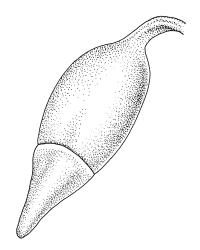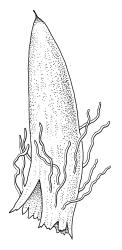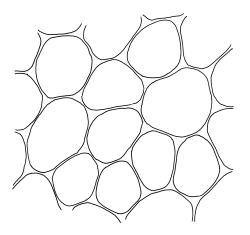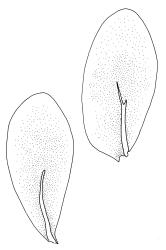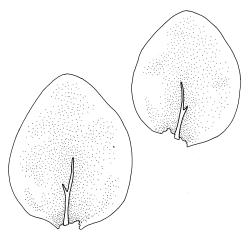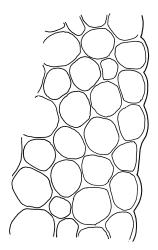- ≡ Hookeria quadrifaria Sm., Trans. Linn. Soc. London 9: 277 (1808)
- ≡ Leskea quadrifaria (Sm.) Schwägr., Sp. Musc. Frond. Suppl. 1(2), 160 (1816)
- ≡ Pterygophyllum quadrifarium (Sm.) Brid., Bryol. Univ. 2, 347 (1827)
- ≡ Mniadelphus quadrifarius (Sm.) Müll.Hal., Linnaea 21: 196 (1848)
- = Hookeria luteovirens Colenso, Trans. & Proc. New Zealand Inst. 17: 260 (1885) – as luteo-vivens
- = Hookeria atrovirens Colenso, Trans. & Proc. New Zealand Inst. 21: 46 (1889)
- = Hookeria sexfaria Colenso, Trans. & Proc. New Zealand Inst. 21: 45 (1889)
- = Pterygophyllum quadrifarium f. marginata Sainsbury, Rev. Bryol. Lichénol., n.s. 16: 47 (1947)
Plants yellow-green when fresh, usually pale brown or rarely black when dry. Stems sparsely branched or unbranched, red-brown, (20–)40–60(–200) mm, in cross section with outermost 5–6 cell layers with moderately thickened walls. Shoots (6–)8–14 mm wide. Leaves inserted in 8 ranks, imbricate, moderately crisped and pale when dry (often undulate at margins), reviving readily when moistened, those in dorsal and ventral ranks broadly ovate to cochleariform, those in lateral ranks obovate to spathulate, with broadly rounded apices, entire or finely and regularly toothed by projecting cell ends in upper portions (teeth never multi-cellular), (3.0–)4.5–6 mm × (2.0–)2.5–3.5 mm (dorsal and ventral leaves smaller), with individual cells concave and highly reflective when dry, with a pale (often appearing thickened) border formed by 1–3 rows of thick-walled cells; upper laminal cells rounded-hexagonal in outline, firm walled (5–9 µm at thinnest part, rarely less), weakly to moderately thickened in corners, the exposed (abaxial and adaxial) walls very thin, collapsed and highly reflective when dry, 60–150 µm in greater diam., becoming gradually longer and ± porose towards base; marginal cells markedly smaller and firmer-walled and lacking collenchymatous thickenings in 1–3 rows, forming a moderately defined border in upper portion of leaf. Costa unequally bifurcate above or unbranched, c. 100–150 µm wide in lowest ⅓ (above basal dilation), ½ to ⅔ the length of the leaf, in cross-section weakly convex on both surfaces, composed of firm-walled, ± isodiametric cells throughout, lacking stereids. Gemmae infrequent, L- or T-shaped, c. 6 cells and to 250 µm long. Pseudoparaphyllia mostly oblong, tapered to an acute apex, c. 1500 µm long.
Dioicous. Perichaetial leaves acuminate from an oblong base, c. 2.0–2.5 mm. Perigonia globose to ovoid, scattered on ♂ stems, c. 1.3–1.5 mm long. Setae 15–35 mm; capsules narrowly ovoid from a wrinkled neck, 1.5–3.2 mm, not or weakly constricted below the mouth when dry, pale yellow-brown; exothecial cells oblong, collenchymatous; operculum long-rostrate from a conic base, 1.5–2 mm. Exostome teeth c. 710–750 µm long, transversely striate, with a furrow 30–36 µm wide near base, and extending c. ¾ the length of the tooth, with strong marginal trabeculae (projecting to c. 20 µm); endostome from a basal membrane c. 300 µm high, segments c. 200 µm long, keeled, not or weakly perforate. Calyptra to 3.0 mm long, smooth or sparsely covered (mostly densely at base) with long (to c. 1500 µm), hyaline, transversely-walled hairs, the upper portion covered with large, ± hyaline cells. Spores spherical, 12–15(–17) µm.
Brotherus 1925, fig. 600 (as Pterygophyllum quadrifarium)
NI: N Auckland, including offshore islands (LB, GB), S Auckland, Gisborne (Lake Waikaremoana, Makaretu Stream), Hawke’s Bay (Patoka), Taranaki, Wellington; SI: Nelson, Marlborough, Canterbury, Westland, Otago, Southland; St; Ch; A.
Endemic.
Generally terrestrial in shaded, moist situations in a variety of forest types, from kauri and podocarp-broadleaf lowland forest to subalpine southern beech forest. On duff, soil, rock, or rotten wood and often in moist situations in/near streambeds or depressions. Often associated with Schistochila or Sphagnum in wet areas on the forest floor. Less frequently at tree bases (Agathis australis, Prumnopitys ferruginea) or epiphytic (Ripogonum, dead tree limbs). On both main islands it is an uncommon species in drier, eastern regions. It is very poorly documented from the Hawke’s Bay L.D., although there are 19th century collections from "Redclyffe" at Norsewood and from "Myrsine Wood" near Dannevirke made by W. Colenso in the 1880s and lodged in WELT. Documented localities from Marlborough, Canterbury, and Otago are generally from areas of higher elevation and relatively high rainfall. On the North I. ranging to at least 1130 m (Mt. Pihanga, Wellington L.D.), and on the South I. ranging from near sea level (Dolomite Point, Nelson L.D. and Oneone River near Hari Hari, Westland L.D.) to at least 1120 m (Mt Euclid, Nelson L.D.).
Achrophyllum quadrifarium exhibits considerable variability in stature, but less in its microscopic features. When well-developed it is a very striking species that is unlikely to be confused with anything else, although inexperienced students often mistake it for an hepatic. The very large laminal cells of A. quadrifarium are easily distinguished under a hand-lens, and are made obvious by their thick and weakly collenchymatous walls. Also the exposed (abaxial and adaxial) cell walls are exceedingly thin, apparently lacking in secondary thickenings, and, in dried material, collapse to become strongly concave. This collapse gives the dry leaves a distinctive spongy appearance and causes the cell surface to appear highly reflective. This feature is easily observed in surface view using a hand-lens. The entire or minutely toothed leaf margins and the differentiated marginal cells further differentiate this species from A. dentatum. The "conspicuous pale border" cited by Sainsbury (1955) for what he termed the forma marginata commonly occurs in this species from all parts of its range.
Hookeria atrovirens Colenso and Hookeria sexfaria Colenso are included here in synonymy of A. quadrifarium on the basis that Brotherus (1901–1909, p. 933) considered them "kaum specifisch verschieden" from Pterygophyllum quadrifarium.
Achrophyllum haesselianum of Argentina and Chile was compared to A. quadrifarium by its author (Matteri 1972, p. 249). It differs by having smaller laminal cells, stronger costae, and more distinctly toothed leaf margins. Its affinities lie with A. dentatum rather than with the present species.



